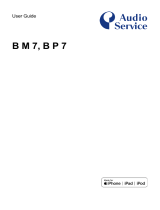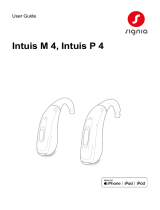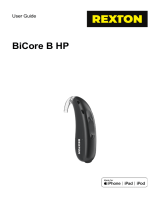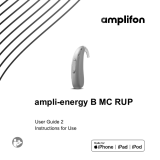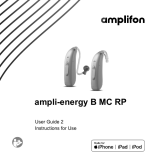
User Guide
Stretta Aya UP

Contents
Welcome 4
Your hearing aids 5
Instrument type 5
Getting to know your hearing aids 6
Components and names 6
Controls 8
Hearing programs 9
Features 9
Batteries 10
Battery size and handling tips 10
Replacing batteries 11
Tamper-proof function (optional) 12
Daily use 14
Turning on and off 14
Standby mode 14
Inserting and removing the hearing aids 16
Adjusting the volume 17
Changing the hearing program 17
Further adjustments (optional) 18
Special listening situations 19
On the phone 19
Audio streaming 19
Audio streaming with iPhone 20
2

Audio streaming with Android phone 20
Bluetooth 20
Audio induction loops 21
Maintenance and care 22
Hearing aids 22
Earpieces and tubes 23
Cleaning earpieces 23
Professional maintenance 23
Further information 24
Safety information 24
Accessories 24
Explanation of symbols 24
Operating, transport and storage conditions 25
Troubleshooting 26
Country-specific information 28
Service and warranty 31
3

WELCOME
Thank you for choosing our hearing aids to accompany
you through everyday life. Like anything new, it may take
you a little time to become familiar with them.
This guide, along with support from your Hearing Care
Professional, will help you understand the advantages and
greater quality of life your hearing aids offer.
To receive the most benefit from your hearing aids, it is
recommended that you wear them every day, all day. This
will help you get adjusted to them.
CAUTION
It is important to read this user guide and the safety
manual thoroughly and completely. Follow the safety
information to avoid damage or injury.
The device may not look exactly like the guiding
illustrations in these instructions. We reserve the right
to make any changes we consider necessary.
4

YOUR HEARING AIDS
This user guide describes optional features that your
hearing aids may or may not have.
Ask your Hearing Care Professional to indicate the
features that are valid for your hearing aids.
Instrument type
Your hearing aids are BTE (Behind-The-Ear) models. A
tube delivers the sound from the hearing aid into the ear.
The instruments are not intended for children under the
age of 3years or persons with a developmental age of
under 3years.
The wireless functionality enables advanced audiological
features and synchronization between your two hearing
aids.
Your hearing aids feature Bluetooth®LowEnergy*
technology allowing for easy data exchange with your
smartphone, and for seamless audio streaming with your
iPhone** and for some Android smartphones that support
Audio Streaming for Hearing Aids (ASHA).
Note, that Bluetooth is not available on all performance
levels.
* The Bluetooth word mark and logos are owned by the Bluetooth SIG, Inc., and any use
of such marks by WS Audiology Denmark A/S of this product is under licenses. Other
trademarks and trade names are those of their respective owners.
** iPad, iPhone, and iPod touch are trademarks of AppleInc., registered in the U.S. and
other countries.
5

Getting to know your hearing aids
It is recommended to familiarize yourself with your new
hearing aids. With the instruments in your hand try using
the controls and note their location on the instrument. This
will make it easier for you to feel and press the controls
while wearing the hearing aids.
If you have problems pressing the controls of your
hearing aids while wearing them, you can ask your
Hearing Care Professional whether a remote control
or a smartphone app to control your instruments is
available.
Components and names
Your hearing aids are attached to an earhook and a
custom-made earpiece.
➊
➌
➋
➍
➎
6

➊ Earhook
➋ Microphone openings
➌ Rocker switch
➍ Battery compartment
(on/off switch)
➎ Side indication (red =
right, blue = left)
Your Hearing Care Professional will attach an earhook,
tube and a custom-made earpiece to each hearing aid.
Custom-made earpieces
Examples:
7

Controls
With the rocker switch you can, for example, switch
hearing programs. The Hearing Care Professional has
programmed your desired functions to the rocker switch.
Rocker switch function L R
Press briefly:
Program up/down
Volume up/down
Tinnitus therapy signal level up/down
TV stream on/off
Press for about 2seconds:
Program up/down
Volume up/down
Tinnitus therapy signal level up/down
TV stream on/off
L=Left, R=Right
You can also use a remote control to change hearing
programs and adjust the volume of your hearing aids.
With our smartphone app you have even more control
options.
8

Hearing programs
1
2
3
4
Read more in section "Changing the hearing program".
Features
The tinnitus therapy signal generates a sound to
distract you from your tinnitus.
A telecoil is built into the instrument, so it can
connect with audio induction loops.
Read more in section "Audio induction loops".
9

BATTERIES
When the battery is low the sound becomes weaker or you
will hear an alert signal. The battery type will determine
how long you have to replace the battery.
Battery size and handling tips
Ask your Hearing Care Professional for recommended
batteries.
Battery size: 675
●Always use the correct battery size for your hearing
aids.
●Remove the batteries if you intend not to use the
hearing aids for several days.
●Always carry spare batteries.
●Remove empty batteries immediately and follow your
local recycling rules for battery disposal.
10

Replacing batteries
Removing the battery:
►Open the battery compartment.
►Use the magnet stick to pull out the
battery. The magnet stick is available as
an accessory.
Inserting the battery:
►If the battery has a protective film, remove it
only when you are ready to use the battery.
►Insert the battery with the "+"symbol
facing up into the battery door
(refer to the picture).
Note: Do not place the battery directly
into the housing.
11

►Close the battery door carefully as it can
be damaged.
Push only in a straight angle and in the
area higlighted in the illustration. Do
not use force.
If you feel resistance, the battery is not
inserted correctly.
Tamper-proof function (optional)
Ask your Hearing Care Professional to enable the tamper-
proof function.
OFF position when not in use:
►The battery compartment can be easily opened by a
few millimeters to turn the hearing aid off.
To ensure that the hearing aid is safely stored in the
vicinity of small children, the battery door must be
opened to the OFF position when the hearing aid is
not in use.
Only open the battery compartment completely when
changing the battery.
How to open the battery compartment:
►Place a small cloth or tissue over the battery
compartment grip.
12

►Open the door with your
thumb as shown in the
illustration.
The force required to open the door is higher than for
the non-tamper-proof setting.
13

DAILY USE
To assure comfortable and easy use of your hearing aids
they are equipped with an onboard control element.
In addition, we offer an app for Android as well as
iPhones which makes handling your devices even easier.
Contact your Hearing Care Professional for downloading
and installing the smartphone app.
Turning on and off
You can turn your hearing aids on or off via the battery
compartment:
►Turning on: Close the battery compartment.
The default volume and hearing program are set.
►Turning off: Open the battery compartment to the first
catch.
When the power-on delay is activated,
the hearing aids turn on after a delay
of several seconds. During this time you
can insert the hearing aids into your ears
without experiencing unpleasant feedback whistling.
The "power-on delay" can be activated by your Hearing
Care Professional.
Standby mode
The standby mode mutes the hearing aids. They are not
turned off completely but still draw some power. Therefore,
we recommend to use standby mode only for a short
period of time.
14

How to switch to standby mode:
●via remote control
●via rocker switch.
Press and hold the rocker switch for several seconds.
Leaving the standby mode:
●The previously used volume and hearing program are
set.
●If you want to leave the standby mode but the remote
control is not at hand, turn your device off and on again
(by opening and closing the battery compartment). In
this case, the default volume and hearing program are
set.
15

Inserting and removing the hearing aids
Your hearing aids have been fine-tuned for your right and
left ear. Colored markers indicate the side:
●redmarker= rightear
●bluemarker= leftear
Inserting a hearing aid:
►Hold the tube close to the earpiece.
►Carefully push the earpiece into
the earcanal➊.
►Twist it slightly until it sits well.
Open and close your mouth to
avoid accumulation of air in the
earcanal.
►Lift the hearing aid and slide it over
the top of yourear➋.
➊
➋
●It may be helpful to insert the right hearing aid with
the right hand and the left hearing aid with the left
hand.
●If you have problems inserting the ear piece,
use the other hand to gently pull your earlobe
downwards. This opens the ear canal and eases
insertion of the ear piece.
16

Removing a hearing aid:
►Lift the hearing aid and slide it
over the top of yourear➊.
►Hold the earpiece between
your thumb and index finger.
Carefully twist the earpiece
forward while pulling itout➋.
Clean and dry your hearing aids after usage. Read more in
section "Maintenance and care".
Adjusting the volume
Your hearing aids automatically adjust the volume to the
listening situation.
►If you prefer manual volume adjustment, press the
upper part of the rocker switch to increase the volume
or press the lower part to decrease the volume.
Refer to section "Controls" for the setting of your rocker
switch.
An optional signal can indicate the volume change. Once
the maximum or minimum volume has been reached, you
may hear an optional signal tone.
Changing the hearing program
Depending on the listening situation, your hearing aids
automatically adjust their sound.
17

Your hearing aids may also have several hearing
programs which allow you to change the sound, if needed.
An optional signal tone can indicate the program change.
►To change the hearing program, press the rocker
switch briefly.
Refer to section "Controls" for the setting of the rocker
switch. Refer to section "Hearing programs" for a list of
your hearing programs.
The default volume is applied.
Further adjustments (optional)
You can also use the hearing aid controls to change other
features, for example, the level of the tinnitus therapy
signal.
Refer to section "Controls" for the setting of your controls.
18

SPECIAL LISTENING SITUATIONS
On the phone
When you are on the phone, hold the
telephone receiver slightly above your ear.
The hearing aid and telephone receiver
have to be aligned. Turn the receiver
slightly so that the ear is not completely
covered.
Telephone program
You may prefer a certain volume when using the phone.
Ask your Hearing Care Professional to configure a
telephone program.
►Switch to the telephone program whenever you are on
the phone.
If a telephone program is configured for your hearing
aids, it is listed in section "Hearing programs".
Audio streaming
The following information on audio streaming does not
apply to all models of the hearing aid. Ask your Hearing
Care Professional to indicate the features that are valid for
your hearing aids.
19

Audio streaming with iPhone
Your hearing aids are Made for iPhone hearing aids. This
means you can get phone calls and listen to music from
your iPhone directly into your hearing aids.
For more information about compatible iOSdevices,
pairing, audio streaming and other useful functions,
contact your Hearing Care Professional.
Audio streaming with Android phone
If your mobile phone supports Audio Streaming for Hearing
Aids (ASHA), you can get phone calls and listen to music
from your mobile phone directly into your hearing aids.
For more information about compatible Androiddevices,
pairing, audio streaming and other useful functions,
contact your Hearing Care Professional.
Bluetooth
Your device is equipped with Bluetooth®* wireless
technology to enable audio streaming from mobile phones
or other compatible devices.
In an airplane, the use of Bluetooth functionality may be
restricted, especially during take-off and landing. If this is
the case, you can switch off Bluetooth wireless technology
in your device via the smartphone app.
* The Bluetooth word mark and logos are owned by the Bluetooth SIG, Inc., and any use
of such marks by WS Audiology Denmark A/S of this product is under licenses. Other
trademarks and trade names are those of their respective owners.
20
Page is loading ...
Page is loading ...
Page is loading ...
Page is loading ...
Page is loading ...
Page is loading ...
Page is loading ...
Page is loading ...
Page is loading ...
Page is loading ...
Page is loading ...
Page is loading ...
/

